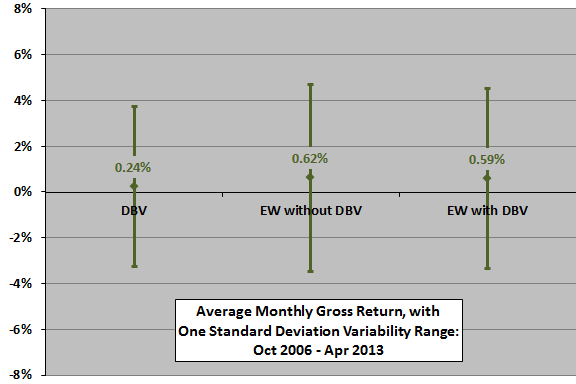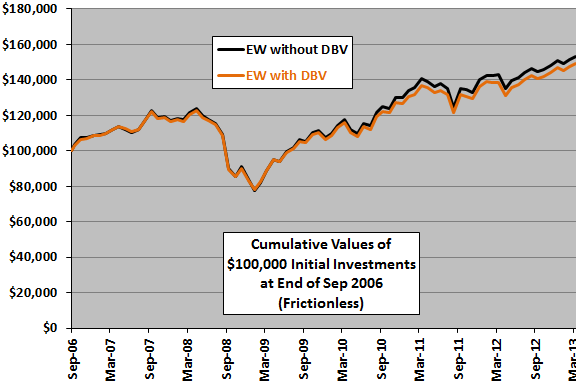Does adding a proxy for the currency carry trade among developed economies (long futures on three currencies with the highest interest rates and short futures on three currencies with the lowest interest rates) to a diversified portfolio improve its performance? To check, we add PowerShares DB G10 Currency Harvest (DBV) to the following mix of asset class proxies (the same used in “Simple Asset Class ETF Momentum Strategy”):
PowerShares DB Commodity Index Tracking (DBC)
iShares MSCI Emerging Markets Index (EEM)
iShares MSCI EAFE Index (EFA)
SPDR Gold Shares (GLD)
iShares Russell 1000 Index (IWB)
iShares Russell 2000 Index (IWM)
SPDR Dow Jones REIT (RWR)
iShares Barclays 20+ Year Treasury Bond (TLT)
3-month Treasury bills (Cash)
First, per the findings of “Asset Class Diversification Effectiveness Factors”, we measure the average monthly return for DBV and the average pairwise correlation of DBV monthly returns with the monthly returns of the above assets. Then, we compare cumulative returns and basic monthly return statistics for equally weighted (EW), monthly rebalanced portfolios with and without DBV. We ignore rebalancing frictions, which would be about the same for the alternative portfolios. Using adjusted monthly returns for DBV and the above nine asset class proxies from September 2006 (first return available for DBV) through April 2013 (79 monthly returns), we find that:
The following chart summarizes average monthly returns with variability ranges of one standard deviation for DBV and the EW portfolios without and with DBV over the available sample period. During this time, DBV generates a low positive average return with relatively low volatility. Adding DBV to the diversified EW portfolio has little effect on return and volatility. The ratio of average return to standard deviation (return per unit of risk) is 0.15 (0.15) without (with) a DBV position.
The average pairwise correlation of DBV monthly returns with those of the other assets is a relatively high 0.45 over the available sample period. The relatively high correlation derives from high pairwise relationships with equity assets and DBC.
Per “Asset Class Diversification Effectiveness Factors,” the low positive average return (relatively high average pairwise correlation) of DBV indicates a poor (poor) contribution with respect to portfolio diversification.
Sample size is not large in terms of number of months, and especially, variety of market conditions.
What is the net effect on cumulative portfolio performance?

The next chart compares cumulative values of EW portfolios without and with DBV in the mix over the available sample period. Adding DBV has little effect on volatility and mostly degrades cumulative value over the sample period.
Again, sample size is not large.

In summary, evidence from simple tests over the available sample period does not support belief that adding a proxy for the currency carry trade among developed economies to a diversified portfolio improves overall performance.
Cautions regarding findings include:
- As noted, the sample period is short in terms of market conditions (only one bear market and parts of two bull markets).
- Including the trading frictions associated with monthly rebalancing would depress performance of both portfolios, depending mostly on portfolio size.
See also “Optimized Currency Trading as Portfolio Diversifier”.